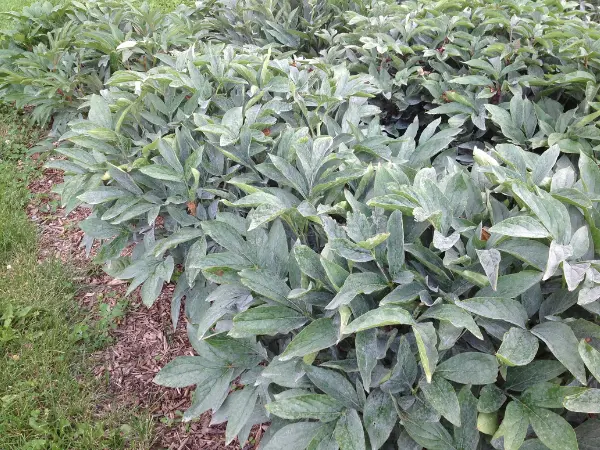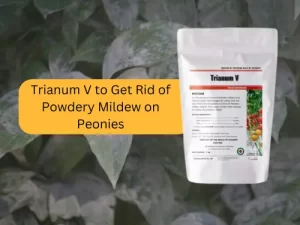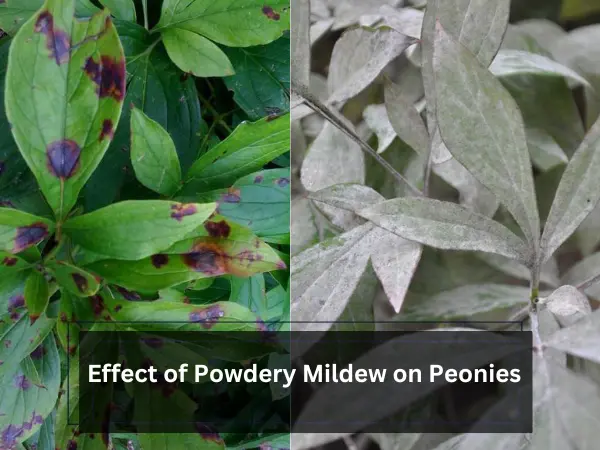Peonies are admired for their exquisite flowers and vivid hues, but powdery mildew on peonies is a common fungal disease that affects them. This disease affects the plant growth and appearance. Even though it can be a recurring problem, the farmers are looking for a solution to how to treat powdery mildew on peonies. In this article, we’ll discuss essential tips to adopt preventative strategies, effective for powdery mildew on peony and use efficient remedies to keep blooms healthy and vivid. You can also use fungicides for powdery mildew on peonies to preserve your plant for a strong and colorful growth.

Maintaining healthy peonies starts with good cultural practices. Let’s delve into three essential techniques to combat powdery mildew on peonies:
1. Strategic Plant Placement: Make sure there is appropriate spacing of around three to four feet, which will enable maximum air circulation. High humidity makes ideal conditions for development of powdery mildew on peony. Leaves should dry quickly for air circulation to deter fungi growth.
2. Harnessing Sunlight: In order for peonies to grow, they should be exposed to about six to eight hours of sunshine daily. Sun acts as a natural cleaning agent which dries up the leaves and hinders germination of powdery mildew. Sunshine is important in improving the general health of your plants and enhances their disease resistance.
3. Mastering Water Management: Water regularly, but do not overdo it. This extra moisture allows for powdery mildew infection on peonies. The soil should be slightly dry before next watering. If the soil is not that dry, it will retain adequate moisture at the ground level that will hinder growth.
These very basic cultural practices in treating powdery mildew on peonies that will greatly lower your chances of getting the disease. It will result in robust and colorful flowers. Other than these, fungicide for powdery mildew on peonies can be used for peonies treatments.
Powdery Mildew Fungicide offers a natural and eco-friendly alternative to chemical fungicides for powdery mildew on peonies treatment. These products utilize naturally occurring substances, such as plant oils, bacteria, and beneficial fungi, to control fungal growth without harming beneficial insects or the environment.

The effective fungicide for powdery mildew on peonies is Trianum-v. It is a natural fungicide that is effective against a wide range of plant diseases, including powdery mildew, botrytis, and other fungal infections. It is made with the active ingredient Trichoderma harzianum, a beneficial fungus that helps to control harmful fungi.
The Advantage of Beneficial Insects:
Trianum-V being a multifunctional natural fungicide helps defend the plant from a variety of diseases including mildews, spots, blights, rots, and molds. Thus, through inhibiting these two diseases and curbing them in the earliest stages, Trianum-V assists in upholding plant healthiness intact. This helps to avoid any stunted crop growth and to yield better results with the enhanced quality of the produce through which the plants become healthier and more prosperous. Additionally, the product Trianum-V is developed to be multi-functional and responds to the plant stress factors, maintaining not only the health but also the longevity of the plants.
Trianum-V is composed in such a way that the probability of cross-resistance is reduced, which makes it a sustainable alternative for disease spread control in agricultural settings. Trianum-V’s wettable powder leaves no residue, making it highly desirable. It aligns with organic farming standards, being suitable for organic farmers. This product protects crops naturally and efficiently against harmful organisms. It allows use anytime, offering flexibility without compromising crop safety or quality. This leads to an integral approach to the protection of plants that shows how sustainable, effective and user-friendly solutions are the ultimate target of modern agriculture.
Trianium-V’s active biological agent Trichoderma Harzianum remedies root diseases like root rot, allowing plants to take up nutrients from soil more efficiently. This results in better soil structure, and positive influence on the hair growth of roots. A straightforward kind of interaction can either be bypassing disease-causing fungi using metabolites that they cannot grow on or penetrating through the cell wall of disease-causing bacteria leading to immune system stimulation of the plant for disease resistance and growth promotion. Biocontrol effectively suppresses soil-borne diseases, ensuring nutrient and moisture absorption more efficiently. It enhances crop quality and yield, promotes environmental health, and preserves soil without resistance or residue issues.

Unlike chemical techniques, biological processes used to cure peony from powdery mildew are environmentally safe. Biological methods utilize natural products that won’t disrupt ecosystems or harm beneficial insects. Unlike typical chemicals, these antifungals ensure your garden’s long-term health. They maintain the garden’s wellbeing and protect the surrounding environment for future generations.
Biological control of powdery mildew in peonies provides durable protection by building up a holistic, well-balanced garden ecosystem. These solutions involve attracting good bugs as well using existing fungus for creating a sustainable environment which is easily overcome by new infection. This approach allows prolonged regulation of powdery mildew on the peonies without reliance on toxic agents.
Biological practices also spare the use of chemical fungicides thereby minimizing possibilities of harming the beneficial insects and pollinators. It is important to ensure this so as to keep a balanced and diverse gardening environment. Biological solutions are also easier to use, not like chemicals which can harm both the user and the organisms around.
Using biological treatments for peonies’ powdery mildew benefits both you and the plants environmentally. These solutions promote robust peony growth and ensure a healthy garden and environment.
To control powdery mildew on peonies, use cultural, chemical (specific fungicides), and biological methods effectively. These combined practices foster a safe synergy that prevents fungal diseases without harm.
Healthy garden, environment-based on cultural practices, which is less likely to be affected by diseases. For example, it involves placing plants strategically in order to ensure optimal air circulation, adequate sunshine exposure, and water management such that there is no creation of a humid environment.
Aspects which might apply for powdery mildew control may include chemical practices that should be utilized for targeted management of the problem. In fact, fungicides should be applied as a measure-of-last recourse on peonies in instances where they are required. Selecting a specific fungicide to be applied on peonies should be accompanied by a detailed manual.
Biological powdery mildew on peonies treatment is an ecologically friendly way to prevent powdery mildew on peonies. These include attracting beneficial insects such as ladybugs and lacewings and using organic fungicides that comprise Trichoderma Harzianum.
Combining these practices will develop a complete solution in controlling the powdery mildew on peonies. As such, it is a safe way of keeping off harmful insects that can threaten your garden hence promoting a healthier garden ecosystem with minimal use of harmful chemical pesticides.
Combating powdery mildew in peonies may seem daunting, but informed methods pave the way to flourish. Strategic planting, proper watering, and targeted fungicide use help fight powdery mildew effectively.
Through cultural control and biological methods, gardeners can effectively subdue this common fungal foe. These practices protect peonies and contribute to a thriving garden environment.
Prevention is important; therefore, begin introducing positive cultural measures at an early stage. Provide your peony with proactive care using holistic strategies that will shield it from the disease known as powdered mildew. Therefore, cheer up, peony fancier, there is a haven free of mildew!
As a plantation owner, I face quite a few..
The banana weevil, also known as Cosmopolites sordidus, is..
Fusarium wilt in banana is usually known to be..

Leave a Reply